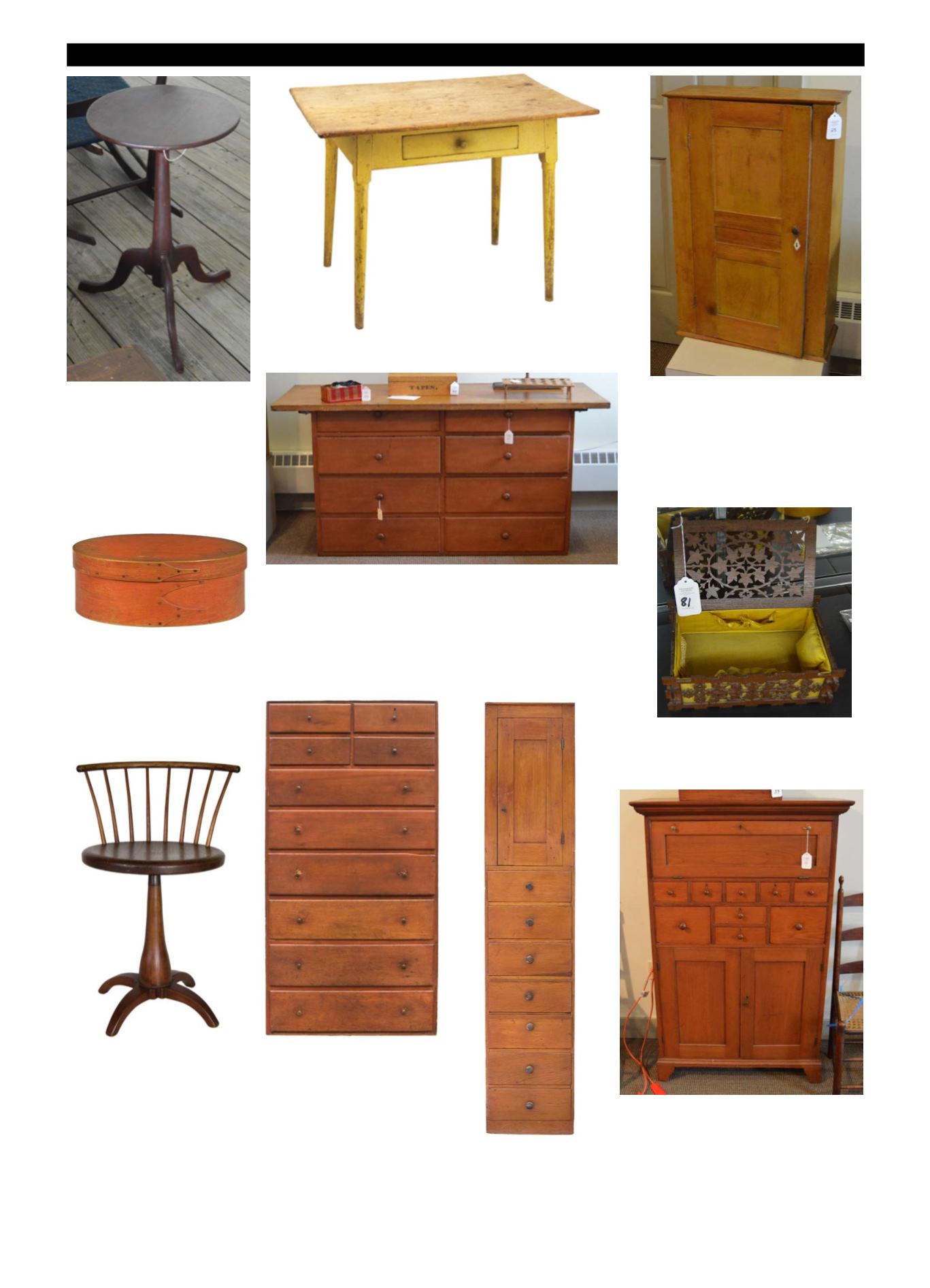

10-C Maine Antique Digest, December 2016
-
AUCTION -
10-C
A 56" tall trustee’s standing desk in pine, retaining
traces of the original red stain and older varnish,
came from the Enfield, Connecticut, community and
had been part of the collections of Don and Carol
Raycraft, Doug Hamel, and Bud Thompson. The
desk is made with a single-board top with half-round
molding over cove molding, an inset panel concealing
a writing surface, and eight cubbies below a shelf, over
five flanking drawers over two stacked drawers, each
flanked by a larger drawer, and a two-door paneled
cupboard. It sold on the phone for $9600.
This pine hanging cupboard, which had suffered
a coat of white paint over the original yellow,
had been restored to the yellow. The panel door,
with a brass pull and a diamond-shaped bone
escutcheon, opens to three interior shelves, one
of which was cut out to accommodate 24 bottles
of various sizes. Based on that shelving, the
cupboard is thought to have been an infirmary
cupboard. It came from an early Connecticut
collection and realized $2040.
The maple candlestand in the original
bittersweet stain and light varnish has a
circular two-board top attached by four
countersunk handmade screws to the
turned shaft on a tripod base with snake
feet and sold for $3900. The stand dates
from between 1840 and 1850 and is signed
“Dimitroff” for Sister Catherine Dimitroff
of the Hancock community. It was
accompanied by history and photographs
of Sister Dimitroff.
This pine and maple worktable in
the original yellow paint, with a sin-
gle-board scrubbed top, a thumbnail-
molded skirt, splayed legs, and a single
drawer, was found near East Canter-
bury, New Hampshire, according to
a tag in the drawer. Made between
1810 and 1830, and from the Ed Clerk
collection, it brought $13,200 (est.
$3000/5000). Willis Henry photo.
A 2
5
/
8
" x 7
1
/
8
" x 4¾" pine and maple
oval box with three fingers, copper
tacks, and steel points, in the original
light tangerine paint on the exterior,
the original yellow on the interior, was,
according to Will Henry, one of Ed
Clerk’s favorite pieces. It was made
between 1830 and 1840 at Canterbury
or Enfield, New Hampshire, and
brought $4560. Willis Henry photo.
A classic revolving chair with a pine seat,
eight maple spindles, a turned hickory
carved back, and a tapered shaft with
four carved legs, circa 1840, came from
the New Lebanon community and sold
for $25,200. A printed paper label beneath
the seat indicated that it had belonged
to Eldress Eliza Ann Taylor, head of
the ministry at Mount Lebanon, New
Lebanon, New York, from 1869 to 1891
and known to all as Eldress Ann. It had
been part of the Brecht collection, and as
he hammered it down, auctioneer Willis
Henry pronounced it “one of the best
revolver chairs ever sold.” Willis Henry
photo.
This Enfield, Connecticut, pine tall
chest, 5'11" x 36" x 17", retains the
original bittersweet-red finish and
was made with a well-dovetailed case,
two small flanking drawers, and two
more flanking drawers over six long
and slightly graduated drawers, one
of which is initialed “AC.” The chest
descended in the family of Arthur
T. Barry, who worked at the Shaker
Station railroad depot, built by the
Shakers to facilitate the movement
of their goods to market and to
accommodate visitors. The chest
brought $32,400 (est. $10,000/15,000).
Willis Henry photo.
Also withKippy Stroud provenance
was this 81¼" x 17" x 17½" pine
cupboard over seven drawers from
the Canterbury, New Hampshire,
community and made between
1840 and 1850 that brought $9000.
Willis Henry photo.
This pine sewing counter came from the collection of eminent collector Marion
“Kippy” Stroud of Philadelphia, where she established the Fabric Workshop and
Museum, and of Mount Desert Island, Maine, where she established the Acadia
Summer Arts Program, and that of John Roberts of Shaker Farm, Canaan, New
York. The counter, in the original reddish-orange stain, was made around 1840.
It has a two-board top in the original yellow stain over eight drawers and was
used in the dairy at Mount Lebanon. It realized $12,000 (est. $10,000/20,000).
Stroud was a well-respected regular at Willis Henry Auctions, where her insights
into Shaker design and values were enjoyed by many. Proceeds from the sale of
her collection will help continue the Fabric Workshop and Museum.
This walnut fancy goods sewing box with fancifully
cut designs of diamonds, vines, and oak leaves is
pegged and lined with yellow silk. It was made in the
Enfield, Connecticut, workshop of Thomas Fisher
around 1890 and fetched $1260 (est. $400/700).











